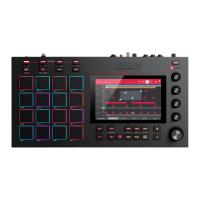503
Updates in MPC 2.11
New Features
MPC Key 61 Support
MPC 2.11 adds support for the Akai Professional MPC Key 61 hardware. For a breakdown of MPC Key 61’s controls,
see Features > MPC Key 61.
MPC Key 61 also includes a new Keyboard Control menu for customizing how its 61-key keybed is used.
To access Keyboard Control, press the Keyboard Control button on your MPC Key 61. You can then edit the
following parameters.
Keyboard Input
Transpose: This determines the amount of transposition to the keyboard, up to 36 semitones up or down.
MIDI Channel: This determines which MIDI channel (1–16) the keyboard input will use to receive messages.
Aftertouch (Channel Pressure): This determines whether aftertouch is enabled (As Played) or not (Disable).
Note On Velocity: This determines the incoming velocity of note on messages. For velocity that is
responsive to your playing, select As played. Alternatively, you can set a fixed velocity for all note on
messages, at 12%, 18%, 25%, 31%, 37%, 43%, Half, 56%, 62%, 68%, 75%, 81%, 87%, 93% or Full
velocity.
Scale Filter
Filter Input: This determines how specific notes are filtered. Select As Played to apply no filtering, Snap to
Scale to shift non-scale notes played to the nearest scale degree, or Filter to Scale to disable non-scale
notes from playing entirely.
Root Note: This determines the root note of the set scale.
Scale: This determines the type of scale used for note filtering. The available scales are:
Chromatic Pentatonic Minor Aeolian Hungarian Gypsy
Major Dorian Locrian Persian
Natural Minor Phrygian Blues Major Bebop
Harmonic Minor Lydian Flamenco Whole Tone
Pentatonic Major Mixolydian Gypsy
Internal Keyboard Routing
Keyboard Route: This determines where MIDI data from the keyboard is sent. Select from the following
options:
Local Off: Keyboard MIDI data is only sent to the MIDI out. This may be useful if working with external
sound modules.
Global: Keyboard MIDI data will always go to the current track.
Tracks: The Keyboard will appear as a port in the list of available track MIDI Inputs.
Global and Tracks: Keyboard MIDI data will go to the current track and be available as a track MIDI
input.

